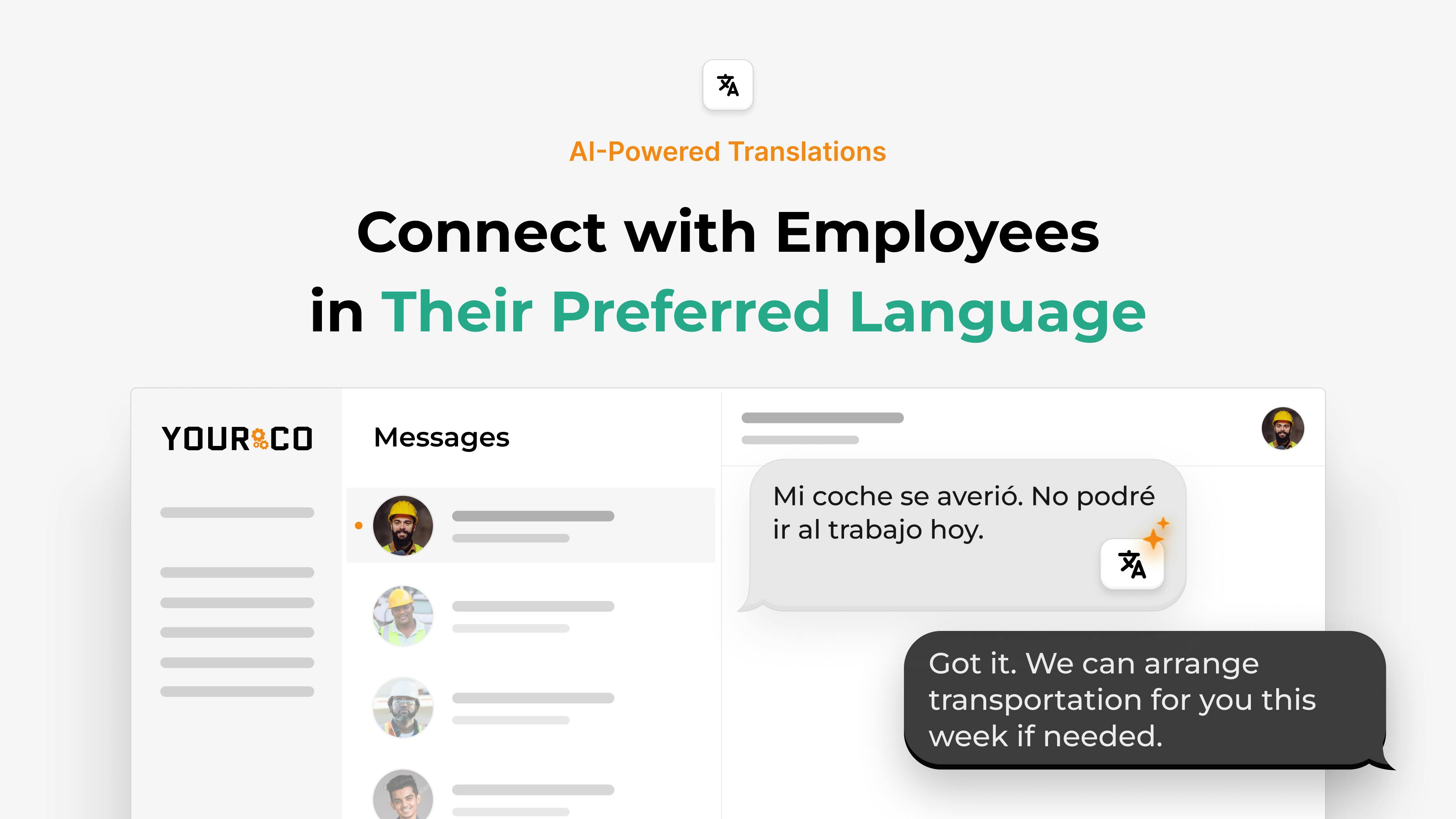7 Proven Steps to Onboard Spanish-Speaking Employees


Hiring Spanish-speaking employees is a smart move for companies across many industries, but welcoming them the right way takes more than just translating a few HR forms. Without clear communication from the start, even the most qualified new hire can feel confused, left out, or unsure about expectations. And when safety policies, tax forms, or onboarding instructions don’t make sense in their preferred language, it creates unnecessary risks for both the employee and the company.
That’s why a thoughtful onboarding process matters. One that not only meets compliance standards but also helps every Spanish-speaking hire feel confident, respected, and fully equipped to do their job. From assessing language needs before day one to using the right communication tools on the job site, this seven-step guide demonstrates how to create an onboarding experience that genuinely works for everyone.
1. Assess Language Needs & Compliance Requirements
OSHA expects safety information to be delivered in a language workers understand, and misunderstandings have serious costs. Paperwork errors and safety incidents rise when forms aren't available in Spanish, which exposes employers to fines and injury claims. Additionally, untranslated I-9 or W-4 forms often return incorrect, creating avoidable legal risks.
To avoid compliance issues, start mapping language skills and compliance gaps before an employee’s first day. Quick pulse-style surveys, short interviews, or SMS polls will help you learn how comfortable each new hire is with spoken and written languages. Platforms with built-in translation features let you send a link employees can complete on their phones, even from a jobsite.
Once you know the new hire’s language preferences and proficiency, you can address regulatory compliance in the language best suited to them, avoiding confusion and costly mistakes. If you have a large number of Spanish-speaking team members, it’s a good idea to keep training materials available in both English and Spanish.
Finally, repeat your language audit regularly. A quick SMS check-in after 30 days confirms whether materials are being received and flags any new gaps, ensuring compliance and keeping your people confident.
2. Translate Core Documentation & Digital Forms
With the essentials out of the way, it’s time to put every document your new hire will touch into a clear, accurate employee handbook in Spanish.
Focus first on the paperwork that shapes the employment relationship:
- Employment offers and contracts
- Safety policies and site-specific procedures
- Benefits packets
- Tax forms
- Direct-deposit authorizations
When these items are translated, Spanish-speaking employees can review wages, safety rules, and benefits without leaning on an interpreter. That clarity reduces the chance of misunderstandings and improves retention by making staff feel respected and informed about their rights and responsibilities.
Use high-quality translation methods, whether that’s a professional translator, a trusted bilingual team member, or platforms that support automated translation. While tools are ideal for everyday messages, policies, and updates, more complex materials like handbooks or legal documents may still benefit from a professional review to ensure accuracy and tone.
Next, build a workflow that updates both sets at the same time: translate, review, and publish. That way, you’re never scrambling to fix mismatched policies again. Modern HR platforms with built-in multilingual support allow employees to toggle between English and Spanish on W-4s, I-9s, and safety acknowledgments, capturing electronic signatures in their preferred language.
3. Deliver a Bilingual & Culturally Aware Orientation
If your team includes a significant number of Spanish-speaking employees, or even just a few in high-risk or highly collaborative roles, a bilingual orientation can make a major difference in safety, engagement, and retention. The goal isn't just to translate policies word-for-word, but to ensure true comprehension from day one.
Decide When Bilingual Orientation Is Necessary
Start by identifying whether a bilingual orientation is needed. Look at the size of your Spanish-speaking workforce, the complexity of job tasks, and how much training they’ll need to complete safely and confidently. If multiple new hires share the same language background, running a session in Spanish (or with a live interpreter) can help everyone participate more fully and ask questions without hesitation.
Address Cultural Norms Early
Cultural awareness matters just as much as language. Some employees may come from environments where direct questions are discouraged or where safety protocols are handled differently. Use your orientation time to encourage questions, explain safety expectations clearly, and introduce key contacts in both languages. Even small efforts, such as bilingual name tags or translated schedules, convey a message that Spanish-speaking employees are valued team members.
Use the Right Tools
Platforms that offer Spanish interfaces for forms and checklists remove friction before onboarding even begins. Short videos with Spanish subtitles, pictograms, and hands-on demos are effective in noisy, non-desk environments. Visual aids enhance comprehension in multilingual groups and remain current when policies change. It also helps to have a go-to onboarding template in Spanish, so every new hire starts with the same clear information. A go-to onboarding template in Spanish also helps ensure every new hire starts with the same clear, consistent information.
Don’t Overlook Cultural Context
Open the session by explaining how feedback flows within your organization. Discuss the hierarchy directly, as many Spanish-speaking employees may wait for explicit permission to speak up. Ensure that everyone leaves day one knowing how to ask questions or raise concerns.
Reinforce with Microlearning
Keep lessons short and spaced out. Microlearning modules delivered over the first week reinforce orientation topics without overwhelming workers who are still mastering new tools and workflows. This approach helps information stick while respecting the reality of learning a new job in a second language.
In a manufacturing setting, this could take the form of a brief daily text or video covering one safety protocol at a time, such as lockout/tagout on Monday, proper lifting techniques on Tuesday, and PPE reminders on Wednesday, and so on.
By meeting new hires in their language and honoring their cultural norms, you build trust from the start. A thoughtful, bilingual orientation is about showing every employee they belong here.
4. Leverage Real-Time Communication Technology
You need a channel every Spanish-speaking new hire will see, understand, and trust. SMS delivers exactly that. Text messages have a 98% read rate, while email hovers near 20%. Unlike email, SMS works on any phone with no apps or internet required, which is an important advantage for non-desk crews scattered across job sites or shifts.
Modern platforms like Yourco let you pre-set the language for each recipient, so you can send every reminder automatically in Spanish. When integrated with your HR system, these tools push out welcome notes, safety videos, or W-4 links in the right language and track who's completed what. If a document remains unsigned, the system sends follow-up messages, creating a built-in compliance trail.
SMS also outperforms popular alternatives for practical reasons. WhatsApp handles rich media but demands smartphones and data plans that many field workers don't have. Other employee communication apps offer dashboards but require downloads and logins that workers often skip. In contrast, plain texts load instantly, even in low-signal zones, and feel less intrusive than social messaging threads. For HR, that simplicity means fewer tech headaches and faster responses.
But don’t just broadcast. Make the conversation two-way. A quick "¿Tienes preguntas sobre tu equipo de protección?" (“Do you have any questions about your PPE?”) invites immediate feedback, uncovering confusion early and reinforcing that questions are welcome. Managers can broadcast emergency alerts in Spanish, while workers can text back photos of hazards or ask for clarification in real time.
5. Provide Role-Specific Training in Preferred Language
Effective training speaks directly to what employees need to know for their specific role. Start by organizing your content into three clear tracks: safety, technical, and soft skills.
This structure helps new hires see how each lesson connects to their daily work and makes it easier for you to slot language-specific resources into the right spots.
Safety Training: Prioritize Clarity
Safety training demands absolute clarity. Translate your manuals, then back them up with videos, diagrams, and pictograms. Even employees with limited reading skills can grasp critical steps when you present information in multiple ways. This visual approach reduces dangerous misunderstandings that can lead to accidents, which is especially important for multilingual teams in high-risk environments.
Technical Training: Match Real-World Tools
Technical training works best when it mirrors the actual tools your teams use. Create short screen recordings with Spanish voice-overs or subtitles that employees can replay during their shifts. Keep it hands-on and directly tied to tasks they’ll encounter on the job.
Soft Skills: Keep It Brief and Practical
For soft skills like conflict resolution or customer service, build scenario-based micro-lessons that take just a few minutes to complete. This microlearning approach keeps people engaged and fits the unpredictable schedules common in deskless roles. Real-world examples help reinforce behavior expectations without overwhelming learners.
Reinforce Learning Through Comprehension Checks
Don't skip the comprehension checks. Quick SMS quizzes, supervisor walk-throughs, or hands-on practice sessions confirm that knowledge sticks and help you catch gaps early. Keep your assessments low-pressure, offer explanations in Spanish, and adjust materials for different literacy levels.
When training is tailored by role and delivered in the employee’s preferred language, it boosts comprehension and builds confidence. And confident workers are safer, faster, and more likely to stick around.
6. Pair New Hires with Support Networks
Beyond formal training, a robust support network will help bridge communication gaps and foster an inclusive work culture. A few proven strategies include:
- Assign a bilingual buddy or mentor: These language buddies can offer informal support, help understand company policies, and reduce any initial feelings of isolation or confusion.
- Create employee resource groups (ERGs): These groups provide a sense of community, offering a space where cultural nuances and experiences are shared. They also serve as platforms for feedback, enabling participants to voice concerns or suggest improvements to HR processes.
- Rotate or compensate mentors: Avoid burnout by rotating mentor roles or offering incentives. This keeps participation genuine and ensures long-term support.
- Train supervisors on cultural and language sensitivity: Equip frontline managers to better understand and support diverse teams. Cross-cultural training promotes respectful communication and stronger relationships between staff and leadership.
For Spanish-speaking employees, offer English-learning opportunities that build confidence on the job. And don’t overlook the reverse — basic Spanish lessons for English-speaking supervisors can go a long way in building trust and reducing friction on the floor.
By prioritizing these strategies, you can create a supportive environment that encourages both retention and job satisfaction for Spanish-speaking employees.
7. Gather Continuous Feedback & Iterate
Perfecting bilingual onboarding requires listening early and often in the language each employee feels most comfortable using. Schedule one-on-one check-ins during week 1, then send quick onboarding surveys at days 30, 60, and 90. Each milestone reveals different pain points as employees settle in.
For deskless teams, an SMS poll is hard to miss and easy to answer. For example, a single text can ask, "¿Recibiste toda la información de seguridad en español?" and link to a two-tap rating scale.
Keep the questions specific. For example:
- “¿El material de entrenamiento fue claro y fácil de entender?”
(“Was the training material clear and easy to understand?”) - “¿Te sientes cómodo hablando con tu supervisor?”
(“Do you feel comfortable speaking with your supervisor?”) - “¿Puedes usar el español en tu trabajo diario sin problemas?”
(“Are you able to use Spanish on the job without issues?”) - “¿Hay algo que aún no entiendes sobre tu rol o las expectativas?”
(“Is there anything you still don’t understand about your role or expectations?”) - “¿Hay algo que podríamos haber hecho para que tu primer mes fuera más fácil?”
(“Is there anything we could have done to make your first month easier?”)
These kinds of targeted, language-accessible questions help you spot gaps early and adjust onboarding before frustration builds.
Yourco supports anonymous mobile surveys and automated message cadences, so you can collect feedback regularly without needing a computer. Scheduled chats with a bilingual supervisor can then follow up on trends, offering space for deeper conversation and course correction.
Keep in mind that the feedback you get through surveys only builds trust when employees see results. Publish a short "You said, we did" update by text or bulletin board, and thank respondents by name when appropriate. For employees who hesitate to criticize authority, invite voice notes or buddy-mediated comments to lower the social risk. Make adjustments quickly, translate all changes, and your onboarding will stay relevant long after day 90.
Welcome Every Employee the Right Way
When you take time to understand the needs of your Spanish-speaking employees, you show every employee that they matter and belong from day one.
Technology, such as real-time SMS communication, enhances accessibility, while role-specific training reinforces comprehension, regardless of language barriers. Additionally, a well-structured support network helps new hires feel part of the team, and regular check-ins ensure your onboarding remains helpful as they settle in.
For companies with Spanish-speaking, non-desk employees, Yourco emerges as an ideal partner. With support for 135+ languages and seamless integration with multiple HR and payroll systems, our platform ensures that communication is clear and accessible to everyone.
Try Yourco for free today or schedule a demo to see how the right communication solution can transform your onboarding process.
Frequently Asked Questions
How do I reach employees who only carry basic cell phones?
SMS works on any device. So even a flip phone receives critical updates and reminders.
What if each location uses a different HR platform?
Yourco syncs with multiple HRIS and payroll tools, pulling employee directories and location data into one place for streamlined daily communications.
Will Spanish texts reflect regional slang or formal language?
Yourco's AI selects neutral Spanish by default, but you can edit messages or add region-specific phrases before you hit send.



